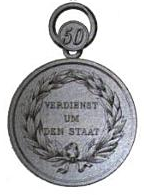The General Honor Decoration (German: Allgemeines Ehrenzeichen) was a decoration of Prussia. The decoration can trace its origin back to awards established in 1793 by King Frederick William III of Prussia. The various levels of the decoration recognized peacetime merit to Prussia.[2] These awards were often to commemorate long and particularly meritorious service or for special contributions from people who would not be considered for appointment to an order due to their rank. In general, recipients were lower and mid-level officials and officers.

The General Honor Decoration originally consisted of a First Class medal in gold, and a Second Class medal in silver. After 1814, the gold medal was discontinued being replaced by a silver cross for the First Class. In January 1830, the cross was made into the Fourth Class of the Order of the Red Eagle,[3] leaving only the silver medal for award. In 1890, a gold medal was reestablished as a higher level class. In 1900, the gold medal was replaced by the Cross of Honour of the General Honor Decoration, which was awarded along with the Second Class Medal, and a Third Class Medal in bronze established in 1912, until the fall Prussia in 1918.


References
- ^ Lundström, Richard. "Prussian Regulations of 24 February 1915 (with amendment 1916)". Guide to German Ribbon Bars 1914-1945. Retrieved 25 May 2013.
- ^ "PRUSSIA. General Honour Award Cross, silver, 1900 (PREUSSEN. Kreuz des Allgemeinen Ehrenzeichens, Silber, 1900), 1900-1918 issue, by Wagner of Berlin". Medal-medaille.com. 2006-02-06. Retrieved 2013-05-19.
- ^ Burke, Bernard (1858). The book of orders of knighthood and decorations of honour of all nations. London: Hurst and Blackett. p. 201.



Recent Comments